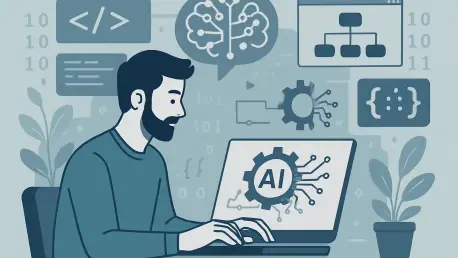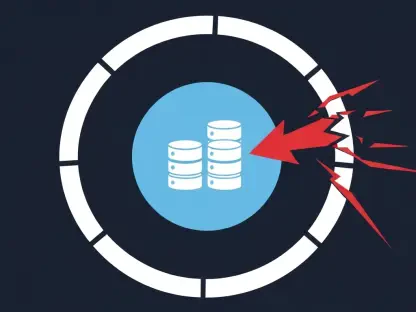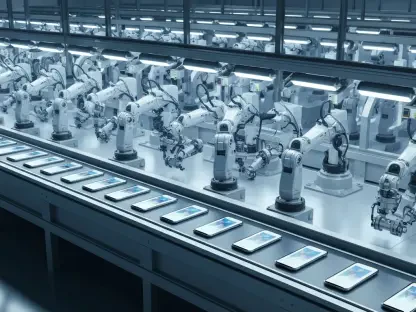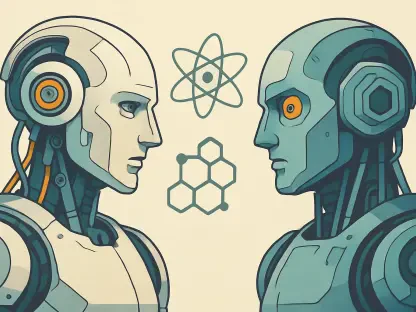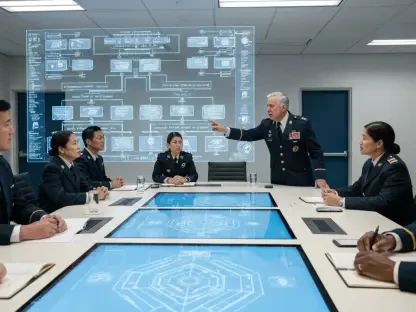Oscar Vail stands at the forefront of technology with his profound insights into emerging fields like quantum computing, robotics, and open-source initiatives. Known for his visionary thoughts, Oscar continues to explore how advancements in AI are reshaping the landscape of software engineering. In today’s interview, he delves into the nuances of AI integration within software development, drawing attention to the broad spectrum of tasks that extend far beyond coding, the pressing challenges that AI faces, and how these might shape the future of software engineering.
What are the main tasks in software engineering that go beyond simple code generation?
Software engineering encompasses a rich tapestry of tasks beyond just coding. It’s about refining designs through refactoring, managing large-scale migrations from old to new code bases, and indulging in rigorous testing to catch any lurking bugs. We focus not only on crafting new features but also on ensuring the performance, security, and maintenance of a project over time. This includes reviewing pull requests, documenting intricate histories of evolving code, and even optimizing complex systems like browsers or GPUs for faster performance. These involve not just writing code but understanding context, a realm where AI has much to learn.
What current challenges does AI face in becoming fully integrated into software engineering?
AI struggles with the breadth and depth of software engineering beyond code generation. One of the major hurdles is seamless human-machine communication. The current interaction with AI systems is minimal, often leading to outputs that might be syntactically correct but semantically flawed. AI also fights with large codebases where proprietary conventions differ greatly from the public data they are trained on, resulting in hallucinations—outputs that seem plausible but don’t fit the actual requirements of the task.
How do these challenges impact the potential for AI to automate routine tasks in software engineering?
The limited understanding that AI currently has impacts its ability to automate tasks fully and reliably. For an AI to effectively take on automation, it must understand the intricacies and contextual meanings behind certain engineering tasks. Miscommunication can lead AI to make errors, such as performing syntactic operations that diverge far from expected corporate or project-specific coding standards. Until these issues are addressed, AI’s role in automating routine tasks will remain constrained and require significant human oversight.
Can you describe how AI could benefit human engineers in the future, especially regarding focusing more on high-level design?
AI has the potential to relieve engineers from mundane, repetitive tasks, thereby allowing them more time to concentrate on high-level design. As AI becomes more adept at handling tasks like debugging, documentation, and code refactoring, engineers can focus on the broader architectural landscape of systems, creative problem-solving, and strategic thinking. This shift allows humans to engage in activities that require understanding of complex business logic, regulatory constraints, and innovative design—areas where their skills are truly indispensable.
What are some of the specific bottlenecks identified in the study that hinder AI’s adoption in software engineering?
One of the bottlenecks is the inadequate measurement standards. Currently, benchmarks like SWE-Bench do not account for the vast complexity of real-world scenarios. These benchmarks focus on limited issues but fail to evaluate performance in large-scale refactoring or optimization needed in industrial-scale practices. Another significant barrier is the communication between AI and humans, which often results in misunderstandings or faulty code suggestions. AI’s difficulty in adapting to proprietary coding conventions also remains a substantial impediment.
How does the current standard of measurement, like SWE-Bench, fall short when evaluating AI’s capabilities in real-world software engineering scenarios?
SWE-Bench and similar benchmarks are designed to assess more straightforward coding problems, akin to academic exercises. They don’t reflect the messy, chaotic nature of real-world software tasks. These standards miss out on evaluating AI’s performance on complex, large-scale code refactoring or the kind of pair programming where AI might need to interact dynamically with human inputs. Until measurements evolve to match these realities, we might find ourselves relying on metrics that don’t paint an accurate picture of AI’s true capabilities.
Why is human-machine communication a significant hurdle in AI-assisted coding?
Current AI systems often deliver their outputs without providing insights into their confidence levels or the rationale behind their decisions. This unilateral communication style increases the risk of mistakenly trusting AI suggestions that might have hidden errors. A more robust dialogue, where AI could highlight uncertainty and invite human verification, is crucial. Without it, developers face an uphill battle trying to parse through or validate AI-generated code that might be syntactically correct but logically flawed.
What issues arise from the scale of current AI models when dealing with large codebases?
For AI, handling large codebases is challenging due to the diversity and complexity inherent in different projects. Each company often has its own proprietary style or set of conventions, which AI models, trained on generic public data, may not accommodate. The result is AI outputs that might look correct on the surface but fail to align with project-specific guidelines or business logic, thus causing integration failures or subtle bugs during deployment.
How does the uniqueness of each company’s coding conventions affect the application of AI models trained on public GitHub repositories?
Each company’s codebase can be dramatically different in style, naming conventions, and architectural patterns from what’s publicly available. Since AI models often build their understanding from such public data, they may fall short when faced with proprietary standards and nuanced business requirements that they’re unfamiliar with. This divergence can lead to outputs that seem feasible but aren’t entirely applicable or useful within the specific contexts these companies require.
What is the concept of “hallucination” in AI-generated code, and why is it problematic?
“Hallucination” in AI-generated code refers to the model producing outputs that are plausible but incorrect or irrelevant in a given context. It’s problematic because these errors can be subtle and hard to detect, leading to potential issues only when the system is deployed. Such hallucinations can result in AI creating code that seems logically sound and even compiles but doesn’t perform the intended function or fit the specific parameters set by a project’s unique coding environment.
Why is it often challenging for AI models to retrieve the correct code, even when syntax is similar?
AI models may be fooled by syntactically similar but functionally different code due to their learning systems, which rely on correlations found in training data without truly understanding the underlying logic. This means that during code retrieval, the models might pick up pieces of code that, while looking correct, don’t necessarily meet the particular needs of the task. Misinterpretations arise because AI isn’t innately equipped to grasp the semantic nuances that differentiate similar-looking code blocks.
What solutions does the study propose to overcome the identified challenges in AI for software engineering?
The study suggests fostering community-scale efforts, such as pooling richer datasets that reflect the real process of software development and creating shared evaluation suites to better measure progress on complex tasks. Transparent tooling that allows AI to express uncertainties or defer to user input is also seen as essential. The collaboration of broader communities, tapping into open-source resources, and iterative research can gradually hone AI’s competence in navigating intricate software engineering landscapes.
What role do the authors see for community-scale efforts in improving AI’s role in software engineering?
Community-scale efforts are seen as fundamental in gathering extensive, diverse data that can teach AI to better comprehend and support real-world software engineering tasks. Collective input can help create shared benchmarks and tools that capture complex interactions within coding environments. This cooperative approach could enable AI to be more contextually aware and versatile, thereby enhancing its ability to assist in challenging engineering functions more effectively.
How can richer datasets and shared evaluation suites contribute to progress in AI-driven software engineering?
Richer datasets can provide a broader perspective on how code is actually developed, adapted, and maintained over time. When AI systems are trained on such diverse data, they gain better insights into handling a wider array of software engineering tasks. Shared evaluation suites ensure consistent measurement of AI’s progress and facilitate comparison across different models and approaches, propelling advancements more swiftly by identifying successful strategies and areas needing improvement.
What are the potential benefits of open-source collaborations in enhancing AI capabilities in software engineering?
Open-source collaborations allow pooling of vast expertise and resources that can lead to faster, more innovative developments. By sharing tools, data, and insights, the community can collectively address challenges too immense for single entities. This cooperative environment not only accelerates problem-solving in AI-enhanced software engineering but also democratizes progress by making advancements accessible for broad application and further innovation throughout the industry.
How can AI complement human engineers rather than replace them, according to the study?
AI is envisioned as an assistant, taking on the more monotonous, repetitive tasks of software engineering that don’t require deep contextual understanding. By automating this tedium, engineers are better positioned to engage in creative and complex problem solving, where their skills in contextual reasoning, strategic planning, and ethical considerations are crucial. The balance ensures that AI handles the groundwork, thus amplifying human potential for innovation and high-level decision-making.
Why is it crucial for AI to deal with the “tedious and terrifying” tasks in software engineering?
By entrusting the drudgery to AI, human developers can focus more on innovation-heavy tasks that demand creativity and advanced problem-solving skills. Handling repetitive or daunting elements like bug-fixing, legacy migrations, or exhaustive refactoring not only eases the workload but also diminishes human error, which can arise from fatigue or oversight. AI management of these tasks can streamline development processes, ultimately leading to more robust and resilient tech ecosystems.
What is your forecast for AI’s role in software engineering?
I see AI becoming an integral partner in the software engineering process. Rather than replacing humans, AI will gradually take on more sophisticated roles as an augmentation tool, spotlighting creativity and strategic innovation. While challenges remain, a collaborative approach involving community-scale efforts promises to break down current barriers. By continuing to refine AI’s ability to understand and execute complex tasks with transparency, the field can move towards a future where AI complements and elevates human engineering capabilities.
